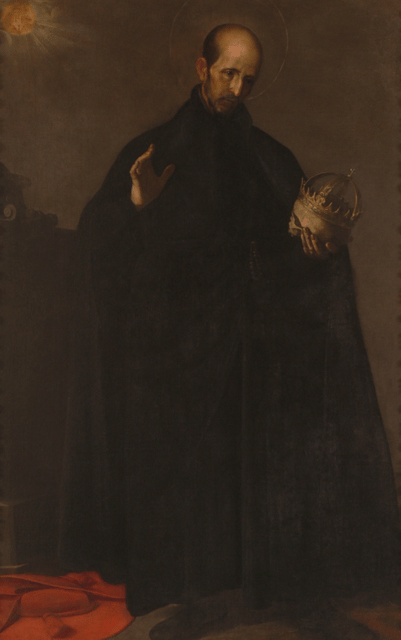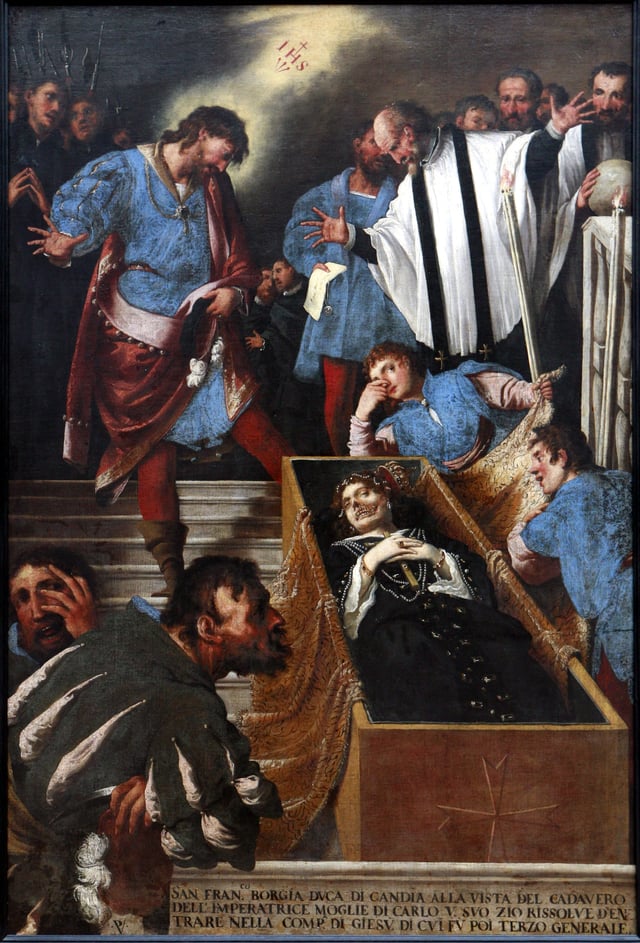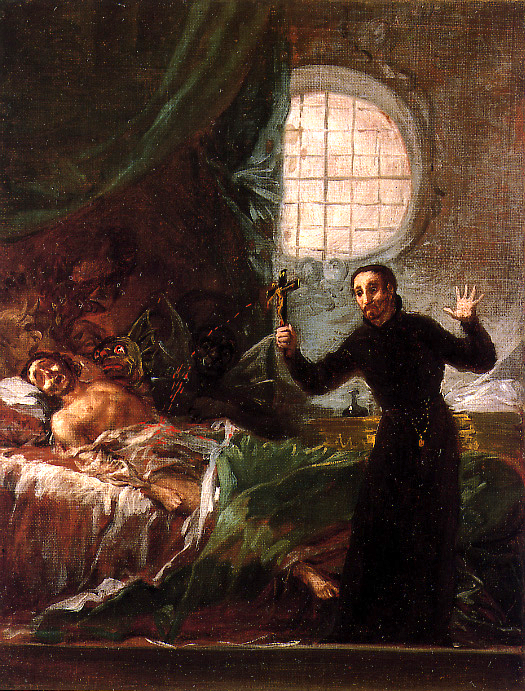Francis Borgia, 4th Duke of Gandía

Francis Borgia, 4th Duke of Gandía

Saint Francis Borgia | |
|---|---|
| Confessor | |
| Born | 28 October 1510 Duchy of Gandía, Kingdom of Valencia, Spain |
| Died | 30 September 1572(1572-09-30)(aged 61) Rome, Papal States |
| Venerated in | Roman Catholic Church |
| Beatified | 23 November 1624, Madrid, Kingdom of Spain by Pope Urban VIII |
| Canonized | 20 June 1670, Rome by Pope Clement X |
| Major shrine | Relics translated to Jesuit church in Madrid, 1901 |
| Feast | 30 September 10 October (General Roman Calendar 1688–1969) |
| Attributes | Skull crowned with an emperor's diadem |
| Patronage | Against earthquakes; Portugal; Gandía; Rota, Marianas |
Saint Francis Borgia, 4th Duke of Gandía SJ (Valencian: Francesc de Borja, Spanish: Francisco de Borja) (1510–1572) was a great-grandson of Pope Alexander VI, a Grandee of Spain, a Spanish Jesuit, and third Superior General of the Society of Jesus. He was canonized on 20 June 1670 by Pope Clement X.
Saint Francis Borgia | |
|---|---|
| Confessor | |
| Born | 28 October 1510 Duchy of Gandía, Kingdom of Valencia, Spain |
| Died | 30 September 1572(1572-09-30)(aged 61) Rome, Papal States |
| Venerated in | Roman Catholic Church |
| Beatified | 23 November 1624, Madrid, Kingdom of Spain by Pope Urban VIII |
| Canonized | 20 June 1670, Rome by Pope Clement X |
| Major shrine | Relics translated to Jesuit church in Madrid, 1901 |
| Feast | 30 September 10 October (General Roman Calendar 1688–1969) |
| Attributes | Skull crowned with an emperor's diadem |
| Patronage | Against earthquakes; Portugal; Gandía; Rota, Marianas |
Early life
He was born in Duchy of Gandía, Valencia, on 28 October 1510. His father was Juan Borgia, 3rd Duke of Gandía, the son of Giovanni Borgia, the son of Pope Alexander VI (Rodrigo Borgia). His mother was Juana, daughter of Alonso de Aragón, Archbishop of Zaragoza, who, in turn, was the illegitimate son of King Ferdinand II of Aragon.[1] His brother, Tomás de Borja y Castro, also became a clergyman, becoming the Bishop of Málaga, and later the Archbishop of Zaragoza.
Although as a child he was very pious and wished to become a monk, his family sent him instead to the court of Charles V, Holy Roman Emperor (who was also King Charles I of Spain), where he was welcomed as a kinsman.[1] He distinguished himself there, accompanying the Emperor on several campaigns.
Adult life and career
In September 1529, he married a Portuguese noblewoman in Madrid, Leonor de Castro Mello y Meneses. They had eight children: Carlos in 1530, Isabel in 1532, Juan in 1533, Álvaro circa 1535, Juana also circa 1535, Fernando in 1537, Dorotea in 1538, and Alfonso in 1539. Charles V appointed him Marquess of Lombay, master of the hounds, and equerry to the empress.[1]
In 1539, he convoyed the corpse of Isabella of Portugal, Philip II of Spain's mother, to her burial place in Granada. In that same year (1539), he became Viceroy of Catalonia, replacing Fadrique de Portugal y Noroña, though he was only 29.
He delighted above all in producing ecclesiastical compositions, and these display a remarkable contrapuntal style and bear witness to the skill of the composer, justifying indeed the assertion that, in the sixteenth century and prior to Palestrina, Borgia was one of the chief restorers of sacred music.[1]
In 1543 upon the death of his father, the 3rd Duke, Francis became the 4th Duke of Gandía.[2] His diplomatic abilities came into question when his attempt to arrange a marriage between Prince Philip and the Princess of Portugal failed, thus ending an attempt to bring these two countries together and resulting in his retirement.[3] By then 33 years old, he had retired to his native place and devoted himself to religious activities.
Jesuit priest

Francis Borgia at Isabella of Portugal's coffin by Pietro della Vecchia
In 1546 his wife Eleanor died, and Francis then decided to enter the newly formed Society of Jesus, after making adequate provisions for his children. He put his affairs in order circa 1551, renounced his titles in favour of his eldest son Carlos de Borja-Aragon y de Castro-Melo, and became a Jesuit priest. He helped in the establishment of what is now the Gregorian University in Rome.[4] Upon Francis’ return from a journey to Peru, Pope Julius III made known his intention to make him a cardinal.[3] To prevent this, Borgia decided, in agreement with St. Ignatius, to leave the city secretly and go to the Basque Country, where it was thought he would be safe from the papal desires.[5] He felt drawn to spend time in seclusion and prayer, but his administrative talents also made him a natural for other tasks. In time his friends persuaded him to accept the leadership role that nature and circumstances had destined him for: in 1554, he became the Jesuit commissary-general in Spain,[6] where he founded a dozen colleges.[4] After only two years, St. Francis was also given responsibility for missions in the East and West Indies.[3] In 1565, he was elected the third "Father General" or Superior General of the Society of Jesus, after the death in January 1565 of Diego Laynez, (Almazán, Spain, 1512 – January 1565).
His successes during the period 1565–1572 have caused historians to describe Francis as the greatest General after Saint Ignatius. He founded the Collegium Romanum, which was to become the Gregorian University, advised kings and popes, and closely supervised all the affairs of the rapidly expanding order. Yet, despite the great power of his office, Francis led a humble life and was widely regarded in his own lifetime as a saint.
Francis Borgia died in 1572.[4]
Veneration
Francis Borgia died on 30 September 1572, in Rome. He was beatified in Madrid on 23 November 1624, by Pope Urban VIII. He was canonized nearly 35 years later on 20 June 1670,[6] by Pope Clement X. His liturgical feast was inserted into the General Roman Calendar in 1688 for celebration on 10 October,[7] the date then free from other celebrations that was closest to that of his death.
Legacy

Borgia and the impenitent dying man by Francisco Goya
Parishes are dedicated to St. Francis Borgia in Chicago, Illinois,[8] Sturgis, Kentucky,[9] Washington, Missouri,[10] Blair, Nebraska,[11] and Cedarburg, Wisconsin.[12] Also in the village of Isio in the town of Cauayan, Negros Occidental, Philippines. The Jesuit-founded city of São Borja, in southern Brazil, is named after him.
Saint Francis Borgia Regional High School is located in Washington, Missouri.[13]
Descendants
Carlos, 5th Duke de Gandía Francisco Tomas, 6th Duke de Gandía Íñigo de Borja Gaspar de Borja y Velasco Baltasar de Borja y Velasco"Baltasar de Borja y Velasco" [22] . Real Academia de la Historia. Retrieved 2019-03-30.
Juan de Borja y Castro
Fernando de Borja y Castro Juan Buenaventura de Borja y Armendia
Isabel Francisco Gómez de Sandoval, 1st Duke of Lerma Juana Gómez de Sandoval Luisa de Guzmán
As the great-great grandfather of Doña Luisa de Guzmán, queen consort of King John IV of Portugal, he is an ancestor of many of the royal houses of Europe.
Ancestry
See also
House of Borgia
Route of the Borgias
Statue of Francis Borgia, Charles Bridge